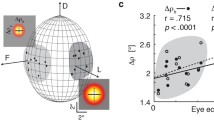Abstract
This paper investigates how the pattern influences the discrimination of different locations of two or more areas of black, white or colour. The coloured patterns were made from two calibrated coloured papers that give contrast only to green receptors, or alternatively only to blue receptors. The patterns are fixed during training. It is found that the discrimination of translocation of two areas of colour involves green receptors and also blue receptors, and the resolution depends strongly on the pattern. Patterns that offer horizontal strips and up-down differences in locations are well resolved, even with no green contrast. Resolution of left-right reversal is greatly improved when the patterns promote fixation in the horizontal plane, as if green contrast is essential to stabilize the eye in yaw. The addition of radial bars with green contrast, a central black spot or a black surround, is particularly effective. The additions promote fixation, and would aid the detection of natural symmetrical objects.
Similar content being viewed by others
Author information
Authors and Affiliations
Additional information
Accepted: 30 May 1999
Rights and permissions
About this article
Cite this article
Horridge, G. Pattern vision of the honeybee (Apis mellifera): the effect of pattern on the discrimination of location. J Comp Physiol A 185, 105–113 (1999). https://doi.org/10.1007/s003590050370
Issue Date:
DOI: https://doi.org/10.1007/s003590050370




